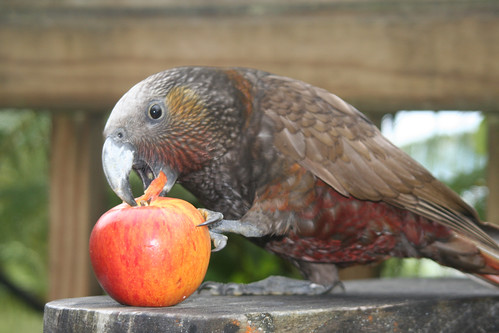 Better than a garden gnome. Photo: DuncanNew Zealand's unique parrots are believed to have evolved from a common ancestor of the Psittacidae parrots more than 80 million years ago.
Better than a garden gnome. Photo: DuncanNew Zealand's unique parrots are believed to have evolved from a common ancestor of the Psittacidae parrots more than 80 million years ago.
This estimate of the timing of a phylogenetic split from all other parrots, coincides with the estimated timing of New Zealand’s separation from the continent of Gondwana - about 82 to 85 million years ago.
In a recent scientific paper, Wright et al (2008), studied the molecular phylogeny of parrots and found phylogenetic evidence to suggest that modern birds first diversified or diverged during the Cretaceous period. Previously, it was believed that birds first diversified about 50 millions years ago in the Tertiary Period.
The study team used the inference of historical bio-geographic patterns to test the hypothesis that the initial radiation of the Order, Psittaciformes (the parrots and cockatoos), originated on the Gondwana supercontinent during the Cretaceous period.
The research supported a Cretaceous origin of Psittaciformes in Gondwana after the separation of Africa and the India/Madagascar block with subsequent diversification through both vicariance and dispersal.
Two tribes of endemic parrots
New Zealand’s rare, endemic parrots (the Kakapo, Kaka, and Kea), make up the Strigopidae family that consists of two sub-families (or tribes); the Strigopini and the Nestorinae. These two sub-families, form a single clade that is sister to all other recent members of the order of parrots, known as the Psittaciformes.
This means that the Strigopidae family are a quite separate branch of the Psittaciformes. Wright et al (2008) also found that the cockatoo clade (Cacatuidae), was sister to a clade containing all remaining parrots (Psittacidae).
The Strigopini sub-family of Strigopidae consists of one genus, the Kakapo (Strigops habroptilus) that was first described by English ornithologist, George Robert Gray in 1845 from Kakapo specimens found in Dusky Sound (in Fiordland, south-west South Island of New Zealand). (Gill et al, 2010).
Kakapo names recall features and behaviour
The unique genus name, Strigops, comes from ancient Greek. ‘Strix’ or ‘Strigos’ means ‘owl’ and ‘ops’ means ‘face’. The second part of the name, ‘habroptilus’, comes from ‘habros’ meaning ‘soft’ and ‘ptilon’ meaning ‘feather’.
These names aptly recall the Kakapo’s main features: a large facial disc resembling an owl, and soft downy feathers. The Kakapo is of course flightless, as well as nocturnal, and one the heaviest parrot in the world.
The Maori name ‘Kakapo’ comes from the Maori ‘Kaka’ meaning parrot and ‘po’ for night; an allusion to the Kakapo’s nocturnal behaviour. The Polynesian name, 'kaka' and a Pacific variation, 'a'a came from South Pacific peoples, probably derived from the word ‘ka’ meaning to screech.
Kaka and Kea from common ancestor
The Nestorinae are believed to have evolved from a ‘proto-kaka’ that was found in New Zealand’s forests about five million years ago. These include the New Zealand Kaka, (Nestor meridionalis) the Kea, (Nestor notabilis), and the now extinct Norfolk Island Kaka (Nestor productus) and Chatham Island Kaka (Nestor species).
The New Zealand Kaka was first described by German naturalist, Johann Friedrich Gmelin in 1788. There are two sub-species of the forest dwelling Kaka; the North Island Kaka, (Nestor meridionalis septentrionalis), and the South Island Kaka, (Nestor meridionalis meridionalis).
These sub-species were divided on morphological and behavioural characteristics, including size and weight, and feeding preferences. Genetically there is very little differentation between them. (Gill et al, 2010).
The other extant genus of Nestorinae, is the Kea (Nestor notabilis), found only in the alpine or high country regions of the South Island of New Zealand. Both the Kaka and Kea are adept flyers and omnivrous feeders, making use of a wide range of foraging options.